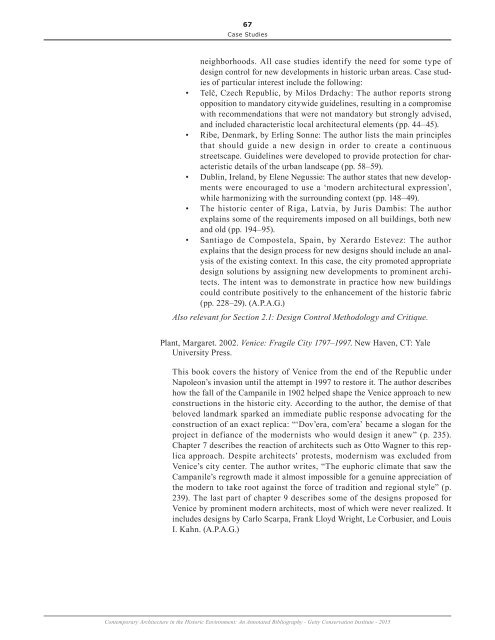Contemporary Architecture in the Historic Environment
cahe_bibliography
cahe_bibliography
You also want an ePaper? Increase the reach of your titles
YUMPU automatically turns print PDFs into web optimized ePapers that Google loves.
67<br />
Case Studies<br />
neighborhoods. All case studies identify <strong>the</strong> need for some type of<br />
design control for new developments <strong>in</strong> historic urban areas. Case studies<br />
of particular <strong>in</strong>terest <strong>in</strong>clude <strong>the</strong> follow<strong>in</strong>g:<br />
• Telč, Czech Republic, by Milos Drdachy: The author reports strong<br />
opposition to mandatory citywide guidel<strong>in</strong>es, result<strong>in</strong>g <strong>in</strong> a compromise<br />
with recommendations that were not mandatory but strongly advised,<br />
and <strong>in</strong>cluded characteristic local architectural elements (pp. 44–45).<br />
• Ribe, Denmark, by Erl<strong>in</strong>g Sonne: The author lists <strong>the</strong> ma<strong>in</strong> pr<strong>in</strong>ciples<br />
that should guide a new design <strong>in</strong> order to create a cont<strong>in</strong>uous<br />
streetscape. Guidel<strong>in</strong>es were developed to provide protection for characteristic<br />
details of <strong>the</strong> urban landscape (pp. 58–59).<br />
• Dubl<strong>in</strong>, Ireland, by Elene Negussie: The author states that new developments<br />
were encouraged to use a ‘modern architectural expression’,<br />
while harmoniz<strong>in</strong>g with <strong>the</strong> surround<strong>in</strong>g context (pp. 148–49).<br />
• The historic center of Riga, Latvia, by Juris Dambis: The author<br />
expla<strong>in</strong>s some of <strong>the</strong> requirements imposed on all build<strong>in</strong>gs, both new<br />
and old (pp. 194–95).<br />
• Santiago de Compostela, Spa<strong>in</strong>, by Xerardo Estevez: The author<br />
expla<strong>in</strong>s that <strong>the</strong> design process for new designs should <strong>in</strong>clude an analysis<br />
of <strong>the</strong> exist<strong>in</strong>g context. In this case, <strong>the</strong> city promoted appropriate<br />
design solutions by assign<strong>in</strong>g new developments to prom<strong>in</strong>ent architects.<br />
The <strong>in</strong>tent was to demonstrate <strong>in</strong> practice how new build<strong>in</strong>gs<br />
could contribute positively to <strong>the</strong> enhancement of <strong>the</strong> historic fabric<br />
(pp. 228–29). (A.P.A.G.)<br />
Also relevant for Section 2.1: Design Control Methodology and Critique.<br />
Plant, Margaret. 2002. Venice: Fragile City 1797–1997. New Haven, CT: Yale<br />
University Press.<br />
This book covers <strong>the</strong> history of Venice from <strong>the</strong> end of <strong>the</strong> Republic under<br />
Napoleon’s <strong>in</strong>vasion until <strong>the</strong> attempt <strong>in</strong> 1997 to restore it. The author describes<br />
how <strong>the</strong> fall of <strong>the</strong> Campanile <strong>in</strong> 1902 helped shape <strong>the</strong> Venice approach to new<br />
constructions <strong>in</strong> <strong>the</strong> historic city. Accord<strong>in</strong>g to <strong>the</strong> author, <strong>the</strong> demise of that<br />
beloved landmark sparked an immediate public response advocat<strong>in</strong>g for <strong>the</strong><br />
construction of an exact replica: “‘Dov’era, com’era’ became a slogan for <strong>the</strong><br />
project <strong>in</strong> defiance of <strong>the</strong> modernists who would design it anew” (p. 235).<br />
Chapter 7 describes <strong>the</strong> reaction of architects such as Otto Wagner to this replica<br />
approach. Despite architects’ protests, modernism was excluded from<br />
Venice’s city center. The author writes, “The euphoric climate that saw <strong>the</strong><br />
Campanile’s regrowth made it almost impossible for a genu<strong>in</strong>e appreciation of<br />
<strong>the</strong> modern to take root aga<strong>in</strong>st <strong>the</strong> force of tradition and regional style” (p.<br />
239). The last part of chapter 9 describes some of <strong>the</strong> designs proposed for<br />
Venice by prom<strong>in</strong>ent modern architects, most of which were never realized. It<br />
<strong>in</strong>cludes designs by Carlo Scarpa, Frank Lloyd Wright, Le Corbusier, and Louis<br />
I. Kahn. (A.P.A.G.)<br />
<strong>Contemporary</strong> <strong>Architecture</strong> <strong>in</strong> <strong>the</strong> <strong>Historic</strong> <strong>Environment</strong>: An Annotated Bibliography - Getty Conservation Institute - 2015
















